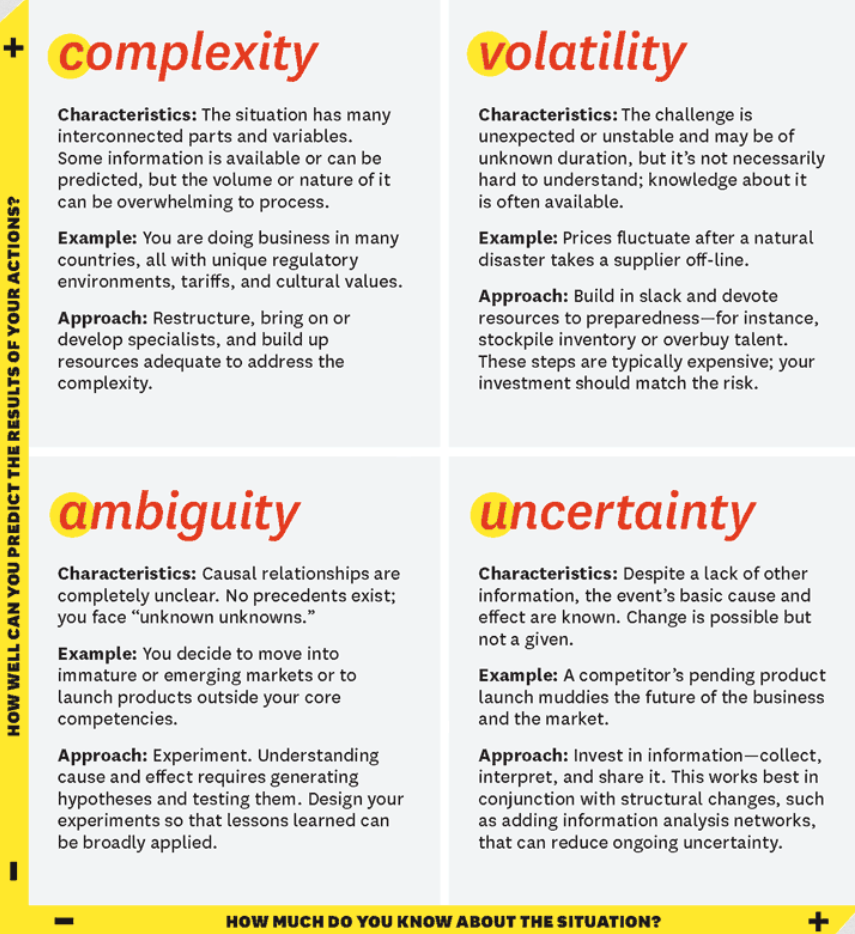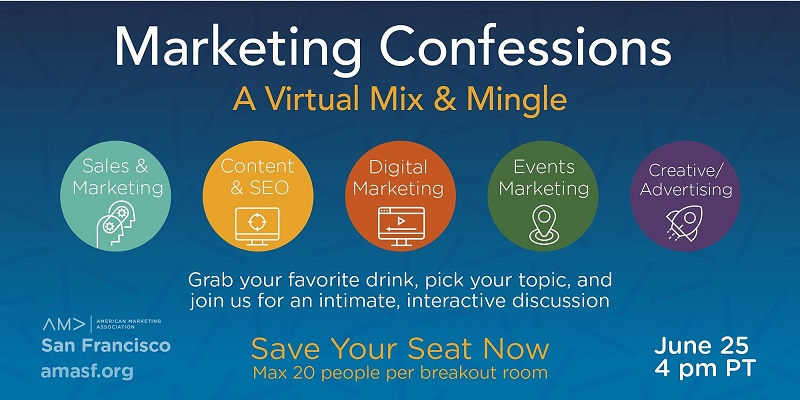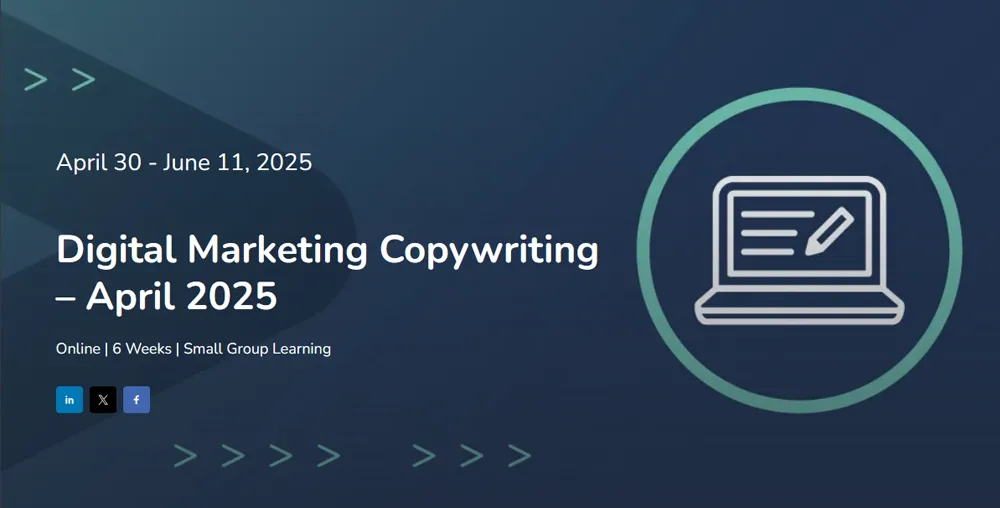Made accessible to all through the power of Zoom, the San Francisco Chapter of the American Marketing Association recently held an online event, “Marketing Confessions: A Virtual Mix and Mingle.” The attendees were first given an initial introduction as a large group before moving into breakout sessions of 15-20 people in order to allow for more personalized conversation.
Sessions were led by the dedicated AMA SF board each speaking to their specialty, and participants were able to choose between a variety of topics: Digital Marketing, Events Marketing, Creative and Advertising, Sales and Marketing, and Content and SEO.
Honing in on content creation, this article discusses the main takeaways from the Content and SEO session and the Creative and Advertising session. The Content and SEO session was led by Jennifer Yan, Founder of SEO Symbiosis and Eric Weidner, Founder and CEO of Workbox. And the Creative and Advertising session was led by Gerardo Garcia-Jurado, Creative Director at The Trust for Public Land and Laliv Hadar, VP Marketing and Brand at InVision Communications.

Content Recycling:
Under the weight of a global pandemic and social upturn, many companies have been using their time to focus on perfecting internal operations. Creating new content that is socially relevant may not always be feasible, the groups discussed. Instead, recycling old, ever-green content can be an effective way to continue to provide for readers and consumers without adding a heavy burden to content writers.
How can content creators know which pieces are worth revisiting?
As Yan explained, “the bread and butter is the marketing research.” Checking to see how competitors are addressing these same challenges, as well as tailoring your approach to what your consumers are hoping to see, will guide your answer. For a digital focus, participants agreed and urged creators to “really dig into the data for your roadmap.”
Moreover, updating and upcycling old successful content can remind consumers of why they initially took note of your content, and re-spark an interest that may have since faded.

Shifting to SEO and Digital:
For an increasing number of companies, in lieu of having in-person events, budgets have been shifted to SEO and digital. This provides increased opportunity for effective SEO and online content — but first requires a strong basis on which to build.
Weidner framed the discussion with a helpful comparison: “SEO is like a free puppy… you ultimately end up paying for it.”
Though utilizing SEO in content marketing can feel like a “free” approach, the hours spent and resources utilized to pass the content along can add up to an impressive sum. Companies must take a realistic look at their expected ROI for the use of any SEO before diving in.
In addition, the group went into helpful tools that they like to use for SEO or digital work. Unbounce is one such example, which will change keywords on your site to accommodate what searchers are looking for. Hotjar was another, which allows for a deeper analysis of website success by creating heatmaps, session recordings, and surveys.

Adding Interaction:
Both groups discussed how to make content feel relevant and took two different approaches.
The SEO group went over the use of polls to add to content effectiveness. For one, your content can then be tailored to what participants share as being most interesting to them. Click-through-rates (CTR) do not reflect what resonates most deeply, or what content is truly adding to/amplifying the consumer’s relationship with the brand.
In addition, polls create the opportunity for an improved empathetic connection between the company and the consumer. Participants are able to express their thoughts and feelings in a way that is directly validating for them, and guiding for marketers.
The Creative and Advertising group, on the other hand, discussed making content feel interactive or more personalized by prioritizing serving the right content at precisely the right time. Focusing in on Gen Z, for example: influencers can be a direct and effective way to present your product or service in a realm that feels removed from the staunch marketing approaches of the past.
This approach can be powerful for companies with smaller budgets, specifically, as there is large potential to significantly connect with new audiences. Additionally, marketers can get a lock on their potential customers through retargeting after. If budgeting cannot account for big influencers, even micro influencers can be easier to use as they are more affordable and may be satisfied with a product or service exchange in lieu of payment.

“The COVID Pivot”
The group discussed how in this self-quarantined, digital age, websites are top of funnel for any company and vital to prioritize. Though not every company was prepared for a hard pivot to e-commerce, every company should now be taking interest.
Some participants shared that they have taken to putting “virtual” or “online” on as much of their communications as possible in order to offer a sense of reassurance to potential customers who may be interested but are hesitant due to COVID concerns. Audiences want empathy from the companies that have their loyalty; they want services that are prepared to adapt to the new normal and a brand that recognizes the challenges that every consumer is likely to be facing.
Lastly, using a time full of significant external challenges as an opportunity to look internal is common because it is effective. Companies should be using this time to take a step back and analyze their normal operations. Marketers should not fear reaching out to their clients directly and asking them about what they need: how are they? Where have they been going for content? These questions offer valuable insight as to the kind of content that creators should be seeking to provide.
Clients appreciate companies who take the time to check in with them; making them feel heard and validated. For content marketers, this is a time to take control of the pivot.

Leading the Charge
All people are currently living in a VUCA world, and learning how to adapt and overcome each new challenge is pivotal for success.
VUCA (standing for “Volatile, Uncertainty, Complexity, Ambiguity”) is a leadership theory that addresses the variety of potential elements to keep in mind when navigating through an uncontrollable environment. By identifying which concerns are most pressing, companies can therefore craft an approach that is most likely to be both realistic and successful.

Harvard Business Review created this helpful infographic to address how the concept of VUCA applies to business.
One challenge on the horizon, outlined the small groups, is the somewhat surprising growing demand for marketing agencies. As companies focus more attention on increasing sales to recuperate recent COVID losses, marketing agencies may be overwhelmed with projects or potential clients.
Agencies should take care to balance the need for clients with the needs of the team members. It will be important to only take on the right accounts whose primary concerns are those that the agency is equipped to handle.






Comments are closed.